Viva Rapid Transit
Viva is the bus rapid transit[1] operations of York Region Transit in York Region, Ontario, Canada. Viva service forms the spine for YRT's local bus service, providing seamless transit service across York Region with connections to northern Toronto.
 | |
 Viva bus at Richmond Hill Centre Terminal | |
| Parent | York Region Transit |
|---|---|
| Founded | September 4, 2005 |
| Headquarters | 50 High Tech Road, Richmond Hill, Ontario |
| Locale | York Region, Ontario |
| Service area | York Region along the Highway 7 and Yonge Street corridors |
| Service type | Bus rapid transit/Quality express bus |
| Alliance | Züm |
| Routes | 6 |
| Fleet | 40 40' units 83 60' units |
| Fuel type | Diesel |
| Operator | Tok Transit |
| Website | Official Website |
Viva was designed and built using a public–private partnership (P3) model. York Region partnered with York Consortium, which comprises seven private sector firms with international experience in transit design, architecture, construction and operations. Under the terms of the partnership agreement, public sector responsibilities include establishing fare policies and service levels, ownership of all assets, and control of revenues and funding. Private sector responsibilities include providing professional staffing and procurement support, assuming risk on all approved budgets and schedules, and assisting York Region in its funding and financing requirements.
Viva opened in stages commencing September 6, 2005. The second stage opened on October 16, 2005, the third on November 20, 2005, the fourth on January 2, 2006, and the fifth on January 27, 2008.
Six routes are in operation: Viva Blue, Viva Purple, Viva Orange, Viva Pink, Viva Green, and Viva Yellow, which opened in November 2015.[2]
Overview

Viva is the first phase of York Region's rapid transit plan to reduce traffic congestion.
The service uses high-end Belgian-built Van Hool and Canadian-built NovaBus buses referred to as "rapid transit vehicles" (RTVs). To maximize speed, buses make use of existing or specially lengthened right-turn lanes bypass lineups at intersections, and of bus-only lanes and roads to avoid traffic. When behind schedule, they are given priority at traffic signals.
Viva operates 18 hours a day, 7 days a week, from 5:30 am to midnight on weekdays, 6:30 am to midnight on Saturdays and 8:00 am to midnight on Sundays. During peak hours (6:30 am to 9:00 am and 4:00 pm to 6:30 pm), buses arrive every three to ten minutes depending on the route. Outside of peak hours, buses arrive 10–45 minutes apart.
Stops along the routes are referred to as "vivastations", and incorporate a ticket vending machine, a ticket validator, and a Presto card reader (fares are on a proof-of-payment basis to speed up boarding times). A real-time display that notifies passengers when the next vehicle is expected to depart. Viva stations are typically blue, except where they are part of a theme.
Viva routes connect to stations on Line 1 Yonge–University and Line 4 Sheppard of the Toronto subway, as well as GO Transit railway stations and bus terminals. Viva is integrated with YRT's existing bus network, and passengers pay one fare to use Viva and the regular bus system. Fares are valid for unlimited use for two hours from the time of purchase. To speed up boarding times, Viva uses the "proof of payment" system. Rather than have drivers sell fares, passengers obtain tickets at vending machines and Viva officials occasionally check to ensure all passengers have paid their fare.
Routes
| Line | Opening Date | Terminus | Stations # | Running time (mins)[lower-alpha 1] | Service | Connecting Services | |
|---|---|---|---|---|---|---|---|
Blue |
September 4, 2005 (Finch to Bernard) November 20, 2005 (Bernard to Newmarket) |
Finch | Newmarket | 27 | 73 (off-peak), 80 (peak) | Full service | |
Purple |
September 4, 2005 (Richmond Hill Centre to Town Centre) October 16, 2005 (Town Centre to McCowan) January 27, 2008 (McCowan to M–S Hospital) |
Richmond Hill Centre Terminal | Markham Stouffville Hospital | 25 | 80 (off-peak), 88 (peak) | Full service | |
Orange |
October 16, 2005 (Martin Grove Road to Vaughan Metropolitan Centre) December 17, 2017 (Vaughan Metropolitan Centre to Richmond Hill Centre)[3] |
Martin Grove | Richmond Hill Centre Terminal | 17 | 53 (off-peak), 55 (peak) | Full service | |
Pink |
January 2, 2006 | Finch | Unionville | 21 | 56 | Peak service (6:30–9:30; 15:30–19:00) | |
Green |
October 16, 2005 (Don Mills to 14th Avenue) November 20, 2005 (Warden to McCowan) |
Don Mills | McCowan | 12 | 50 | Peak service (6:30–9:30; 15:30–19:00) | |
Yellow |
November 29, 2015[4][2] | Newmarket Terminal | Davis Drive and Highway 404 | 7 | 15 | Full service | |
- Running time based on normal traffic and weather conditions, retrieved from the YRT website
As YRT’s mandate does not include local service in the city of Toronto, Viva vehicles travelling south of Steeles Avenue (the regional boundary) do not pick up passengers when travelling southbound to connect to Toronto subway stations, and do not allow passengers to disembark when travelling north.
In 2009, YRT/Viva bus schedules became available on Google Transit; trip planning, detours, and fare information are available to riders over the Internet.[5]
Major locations and terminals
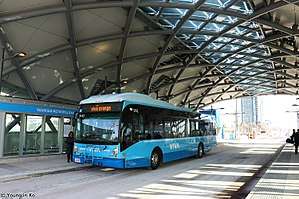
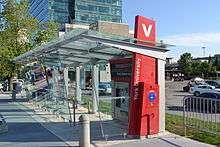
Viva operates at several major locations and terminals, with Viva stations (the names of the stations in brackets) at:
- Finch Bus Terminal - north of Finch TTC station. An elevator and Viva fare machines are available.
- Newmarket Terminal - across from Upper Canada Mall on Davis Drive, at Eagle Street West (Newmarket Bus Terminal).
- Richmond Hill Centre - Yonge Street at Highway 7/Highway 407 next to Silvercity Richmond Hill theatres. Langstaff GO Station is accessible through a pedestrian overpass.
- Promenade Terminal - in Vaughan on the north side of Promenade Mall (T&T Supermarket), on Centre Street west of Bathurst Street.
- Bernard - on east side of the mall on Yonge Street at Bernard, just north of Elgin Mills Road.
- Don Mills station - located outside the TTC's Fare Paid Zone, near Fairview Mall (Don Mills Station) on Don Mills Road opposite Leith Hill Road, just north of Sheppard Avenue, as well as inside the fare-paid zone.
- Unionville Station - located adjacent to the Highway 407 and Kennedy Road interchange (exit 88) in the city of Markham.
- Markham-Stouffville Hospital - located near the hospital on Church St. and Country Glen Road. in Markham near 9th Line and Highway 7.
- Vaughan Metropolitan Centre - Located on Highway 7 west of Jane Street
Some station shelters along Yonge Street north of Steeles along Yonge utilize Gablet roof design: Clark Avenue, John Street, Centre Street, Royal Orchard, Bay Thorn.
Future terminals
The opening of Cornell Terminal had been planned for July 2007, but it has been postponed to 2020.[6] The terminal is to be built south of Markham Stouffville Hospital, near the intersection of Ninth Line and Highway 7. Construction of the terminal began on July 31, 2018. The current Markham Stouffville Hospital terminus is a standard VivaBRT stop in an area next to the hospital.
Fares and payment
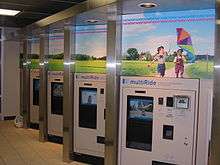
Viva services are considered part of YRT, and hence are covered by the same system.[7] This means riders can transfer between Viva services and other YRT services without paying an additional fare. Riders can also transfer from TTC buses operating in York Region, assuming that they have paid the YRT fare when boarding the TTC bus (when in York Region) or exiting the TTC bus (when travelling to York Region from Toronto).
Unlike conventional YRT buses, Viva buses are not equipped with onboard fareboxes.[7] Riders must purchase or validate their fare from "oneRide" ticket machines, available at all Vivastations. In addition, riders may purchase multiple ride fares from authorized vendors or at "multiRide" ticket machines, available at select terminals where Viva operates. Single ticket fares are good for a two-hour time window (expiry time printed on ticket) on any Viva or YRT route. In July 2011, the Presto card smart card was launched in York Region, providing another payment method.
Rapidways
Often referred to as a transitway or busway by other transit authorities, the term "rapidway" is used to describe the bus-only lanes being designed as part of the bus rapid transit component of the VivaNext plan.[8] The proposed benefit of the rapidways is that Viva vehicles will be able travel faster than before, by avoiding the congestion associated with mixed traffic. While most rapidways will be located in the centre median of roadways, they may also be located curbside to accommodate certain conditions. Rapidway projects funded for construction in York Region are located on Davis Drive, Highway 7 and Yonge Street.[9] Eventually, rapidways could be replaced with a light rail transit system.[10]
History
In November 2008, the provincial transportation agency Metrolinx selected two infrastructure projects for construction beginning in 2009, including major components of the VivaNext plan. Metrolinx gave its final approval to a $7 billion, five-year capital plan that includes over $1 billion for construction of several rapidways.[11]
In the spring of 2009, the Province of Ontario committed $1.4 billion for rapidway construction. The Cornell Terminal in Markham has received $5.6 million in funding through the provincial government's "Quick Wins" program.
Davis Drive rapidway
The Davis Drive rapidway in Newmarket extends 2.6 kilometres from Yonge Street to the Southlake Regional Health Centre.
In November 2009, pre-construction activities, such as utility relocation, planning and geotechnical investigations began for the Davis Drive rapidway. Additional pre-construction activities, such as soil testing, archaeological assessments, building demolition, and removal/relocation of light poles and signs will continue through to the end of 2010. The project was completed in 2015.[12]
Highway 7 rapidway
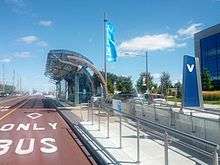
The Highway 7 rapidway is planned to eventually extend from Highway 50 in Vaughan to Cornell Terminal in Markham. It will connect three major urban centres in York Region; Vaughan Metropolitan Centre, Richmond Hill/Langstaff, and Markham Centre.
All stops from Wigwoss-Helen in Vaughan to Post Rd in Markham are currently operational as of January 2020.[13]
Yonge Street rapidway
The Yonge Street rapidway will extend north along Yonge Street from Richmond Hill Centre Terminal at Highway 7 to Green Lane in Newmarket.
The first segment, which extends from Davis Drive to Sawmill Valley Drive/Savage Road in Newmarket, opened on 5 January 2020.[14] The second segment between Highway 7 and 19th Avenue/Gamble Road is expected to open in December 2020.[15]
Vehicles and fleet rosters
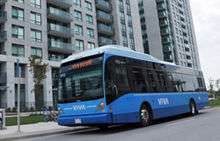
Viva's buses are referred to as Rapid Transit Vehicles (RTVs). Viva operates 56 Van Hool buses and 47 Nova buses. All Viva vehicles are wheelchair-accessible. To reduce time spent loading passengers, Viva routes employ a proof-of-payment fare system. Drivers do not enforce fare payment, but inspectors travel vehicle to vehicle to ensure that passengers have paid their fares. Those caught without valid proof of payment are subject to a fine. Students must produce an authentic student ID card to use student fares (TTC Student ID cards are considered a valid student ID).
| Make/Model | Description |
|---|---|
| Articulated newAG300 | |
| newA330 | |
| Articulated LFX | |
| Articulated LFS |
Future extensions
The VivaNext plan includes the Yonge North Subway Extension of the Yonge subway line north from Finch to Richmond Hill Centre. The Environmental Project Report for the Yonge North Subway Extension was unconditionally approved by the Ministry of the Environment in 2009. This 6.7-kilometre extension is one of the top 15 priority projects of Metrolinx, the provincial transportation agency. A conceptual design contract was initiated in 2010 to maintain momentum on the project and provide a stronger foundation for moving it forward.
Viva Network Expansion Plan (VNEP)
.jpg)
The Viva Network Expansion Plan (VNEP) is York Region's plan to expand the size of Viva's bus rapid transit network. Beginning 2015 through to 2020, the system will expand to include 6-full service and 1-rush hour line. These expansion plans will complement the region's new bus rapidways and subway lines as they open.[16]
By 2020, the following lines are planned to be in service:
- Viva Blue (Yonge) between Finch Subway - Newmarket Terminal (all times), with a branch bypassing Richmond Hill Centre (rush hour only).
- Viva Purple (Highway 7 East) between Richmond Hill Centre - Cornell Terminal (all times), with a branch detouring to Enterprise Blvd (all times except rush hour).
- Viva Orange (Highway 7 West) between Richmond Hill Centre - Highway 50 (all times), with a branch between Finch Subway - Highway 50 (all times).
- Viva Yellow (Davis) between Newmarket Terminal - Highway 404 (all times).
- Viva Green (Leslie/Major Mackenzie East) between Don Mills Subway - Harding (all times).
- Viva Silver (Jane/Major Mackenzie West) between Vaughan Metropolitan Centre Subway - Newkirk (all times).
- Viva Pink (Yonge/Highway 7 East) between Finch Subway - McCowan (rush hour only).
In 2022, York Region Transit will begin service on the Viva Silver route, which will serve Vaughan Metropolitan Centre north on Jane Street to Major Mackenzie Drive, and east to Richmond Hill GO Station.[17]
Subway extensions
Two extensions of the Toronto subway were also planned to integrate with the Viva system. The first extension was opened in 2017.
Toronto–York Spadina Subway Extension
The 8.6 kilometre Toronto–York Spadina Subway Extension includes six stations and run north from the Sheppard West Station in Toronto to the Vaughan Metropolitan Centre Station at Highway 7 in Vaughan[18] and was opened on December 17, 2017.[19]
Yonge North Subway Extension
The Yonge North Subway Extension is planned to run 6.8 kilometres north from Finch Station in Toronto to the Richmond Hill Centre Terminal at Highway 7 and include up to six stations.[20] It will pass through Markham and Vaughan on its way.
2008 driver strike
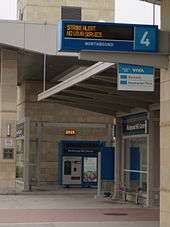
Viva's 170 bus operators are members of Amalgamated Transit Union Local 113, which also represents most unionized staff (over 10000 drivers, ticket collectors and maintenance workers) for the Toronto Transit Commission.[21]
On September 25, 2008, 160 operators walked off the job at 4am EST. 61% of the operators rejected the contract that had been offered the previous week.[22] While Viva service was disrupted, York Region Transit continued to operate as its drivers are represented by a different local of the ATU that did not go on strike.[23]
On October 10, 2008, 65% of the operators voted to accept the contract that they rejected on September 25, ending the 16-day strike.[24] Service resumed at 6am EST on October 11, 2008.
Notes
- "Viva vehicles are so un-bus like, we call them rapid transit". yrt.ca. Archived from the original on July 27, 2011. Retrieved April 27, 2018.
- "Page not found - vivaNext". www.vivanext.com. Archived from the original on May 8, 2016. Retrieved April 27, 2018.
- "YRT/Viva System". www.yrt.ca. Archived from the original on December 22, 2017. Retrieved December 17, 2017.
- "MyTransit Fall 2015" (PDF). yrt.ca. Archived (PDF) from the original on December 8, 2015. Retrieved April 27, 2018.
- "YRT/Viva and Google have teamed up to give riders another trip planning option". Archived from the original on May 25, 2011. Retrieved January 16, 2009.
- "transit terminal / Markham". www.vivanext.com. Retrieved May 19, 2018.
- "Proof of Payment and Transfers". York Region Transit. Retrieved July 25, 2019.
- "frequently asked questions". VivaNext. Retrieved March 12, 2018.
- "Proposed new schedule extends some York Region vivaNext projects by 5 years". CP24. May 19, 2010. Retrieved March 12, 2018.
- "Viva York". vivayork.com. Archived from the original on April 16, 2005. Retrieved April 27, 2018.
- "Metrolinx Capital plan" (PDF). metrolinx.com. Retrieved April 27, 2018.
- "Davis Drive rapidway open". VivaNext. Retrieved March 12, 2018.
- "Project Map". VivaNext. Retrieved March 12, 2018.
- Al-Shibeeb, Dina (January 3, 2020). "New Viva rapidway bus routes in Newmarket, Vaughan open Sunday". Metroland Media Group. Retrieved January 7, 2020.
- "Yonge Street / Richmond Hill". www.vivanext.com. Retrieved March 12, 2018.
- "Viva Network Expansion Plan" (PDF). Archived (PDF) from the original on January 18, 2017.
- "Moving to 2020: YRT/Viva 2016-2020 Strategic Plan" (PDF). York Region Transit. Archived (PDF) from the original on March 11, 2016. Retrieved March 10, 2016.
- "Spadina Subway Extension". VivaNext. Retrieved March 12, 2018.
- "Toronto-York Spadina subway extension $400M over budget". Canadian Broadcasting Corporation. January 15, 2016. Retrieved June 4, 2016.
- "Yonge Subway Extension". VivaNext. Retrieved March 12, 2018.
- "About – ATU Local 113". wemovetoronto.ca. Archived from the original on January 1, 2018. Retrieved April 27, 2018.
- Fleischer, David (September 27, 2008). "Commuters acting responsibly during Viva strike, YRT boss says". Markham Economist and Sun. p. 2.
- Loriggio, Paola; Mathieu, Emily (September 25, 2008). "Viva bus drivers on strike". Toronto Star. Archived from the original on September 28, 2008. Retrieved September 25, 2008.
- Kalinowski, Tess (October 11, 2008). "Striking Viva drivers back in buses". Toronto Star. Archived from the original on October 14, 2008. Retrieved October 11, 2008.
References
Viva publications
- Viva - A Rider's Manual, York Region September 2005
- Viva - York Region Rapid Transit Route Map 2005
- the viva rapid transit vehicle/rtv:ag300 2005
- "Viva RT - New Transit System Coming Soon", About Markham, p. 2. June 2005
- MyTransit, York Region Transit, September 2005. (PDF)
Government publications
- Viva Rapid Transit Phase One Operations and Maintenance Services Contract. Minutes of Council – March 31, 2005, Regional Municipality of York, March 31, 2005.
- Viva Fare Collection Equipment, Maintenance Services Sourcing, Minutes of Council – June 23, 2005, Regional Municipality of York, June 23, 2005.
- Viva rapid transit Fact Sheet, Regional Municipality of York, September 6, 2005.
- Yonge Street Environmental Assessment, Regional Municipality of York, November 10, 2005.
Newspapers
- "vivatalk - York Region's Rapid Transit Update", Economist & Sun/Sun-Tribune: Community, p. 7. June 11, 2005
- "Bus Riders find bearings", Toronto Star, p.B3, September 7, 2005.
Other sources
- "Ontario and Beyond - York Region Rapid Transit Plan", Transfer Points June–July 2004, p. 5-6.
External links
| Wikimedia Commons has media related to Viva. |
- York Region Transit home page
- YRT and Viva bus fare chart
- VivaNext home page – information relating to Viva infrastructure development